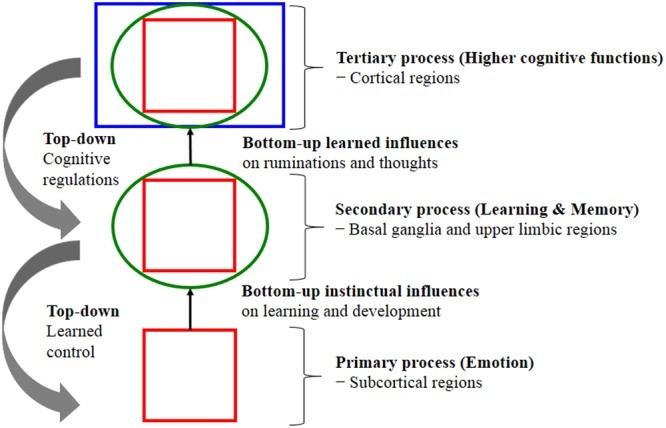Emotions play a crucial role in shaping our learning experiences. From the anxiety of a test to the excitement of discovering something new, emotions significantly impact how we acquire, process, and retain information. This article delves into the complex interplay between emotions and learning, exploring the neurological mechanisms at play and the implications for educational settings.
Conceptual model illustrating the interconnectedness of emotional and cognitive processes in the brain, highlighting the influence of primary emotional systems on higher-order learning and memory functions.
The Science of Emotion and Learning
Emotions are not simply fleeting feelings; they are complex psychophysiological processes that profoundly influence cognitive functions like attention, memory, and problem-solving. Research consistently demonstrates that emotionally charged experiences are more vividly remembered than neutral ones. This “emotional enhancement” of memory is rooted in the interplay between key brain regions:
-
The Amygdala: This almond-shaped structure acts as the brain’s emotional hub, rapidly processing and responding to emotionally salient stimuli. Its activation during learning experiences, particularly those involving arousal, triggers the release of stress hormones that enhance memory consolidation. The amygdala’s influence extends to other brain regions involved in memory, including the hippocampus and prefrontal cortex.
-
The Hippocampus: Crucial for forming new memories, the hippocampus works in concert with the amygdala to encode and consolidate emotionally charged experiences into long-term memory. Studies show stronger hippocampal activation during the encoding of emotional events, leading to more robust and lasting memories.
-
The Prefrontal Cortex (PFC): The PFC, responsible for higher-order cognitive functions like planning and decision-making, plays a critical role in regulating emotions and their impact on learning. Different subregions of the PFC contribute to various aspects of emotional processing, including working memory, semantic processing, and attentional control. For instance, the dorsolateral PFC is involved in maintaining emotional information in working memory, while the ventrolateral PFC plays a role in regulating emotional responses.
Conceptual framework depicting the cyclical interaction between homeostasis, emotion, and cognition, emphasizing the influence of both internal and external factors on these processes.
The Impact of Different Emotions
While both positive and negative emotions can enhance memory, their effects on learning are nuanced.
-
Positive Emotions: Positive emotions like joy, excitement, and curiosity can foster a more receptive learning environment. They increase engagement, motivation, and the willingness to explore new concepts. The release of dopamine associated with positive experiences further reinforces learning and promotes the formation of positive associations with the learning material.
-
Negative Emotions: While often viewed as detrimental, negative emotions like anxiety, frustration, and even confusion can also play a constructive role in learning. These emotions can signal a need for deeper engagement and increased effort. For example, confusion can trigger a desire to seek clarification and a more focused approach to understanding challenging concepts. However, excessive or prolonged negative emotions can hinder learning by narrowing attention, impairing working memory, and creating a sense of aversion towards the learning task.
Modalities of Emotional Stimuli
Emotions can be evoked through various modalities, including visual, auditory, and linguistic stimuli. Neuroimaging studies reveal distinct patterns of brain activation in response to different emotional stimuli. For instance, emotional images tend to elicit stronger amygdala activation compared to emotional words, while emotional sounds activate auditory processing areas in conjunction with emotional centers. Understanding these modality-specific effects is crucial for designing effective learning materials that leverage the power of emotions.
Optimizing Learning Through Emotional Intelligence
The understanding of How Emotions Affect Learning has profound implications for educational practices. By fostering emotional intelligence in both learners and educators, we can create more effective learning environments:
-
Creating Positive Learning Experiences: Incorporating elements of fun, novelty, and social interaction can enhance positive emotions and boost engagement.
-
Managing Negative Emotions: Providing support, clear expectations, and opportunities for mastery can help mitigate the negative impact of anxiety and frustration. Encouraging a growth mindset and emphasizing the value of effort over innate ability can also promote resilience and reduce fear of failure.
-
Utilizing Emotionally Engaging Content: Incorporating storytelling, real-world examples, and multimedia resources that evoke emotions can enhance memory and understanding.
-
Personalized Learning: Tailoring learning experiences to individual emotional needs and preferences can optimize engagement and motivation.
By acknowledging and leveraging the power of emotions, we can transform learning from a passive process to an active and engaging experience that promotes deep understanding and long-term retention. Future research exploring the intricate relationship between emotions and different learning styles, cognitive abilities, and educational contexts will further refine our understanding and inform the development of even more effective teaching and learning strategies.

